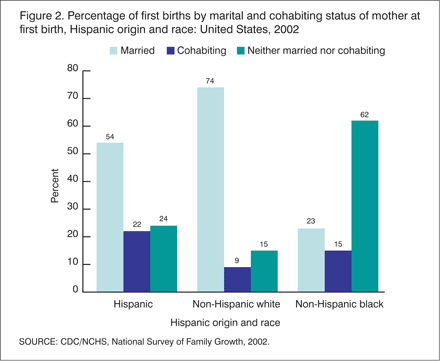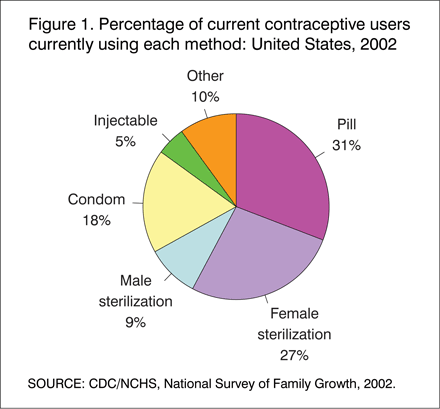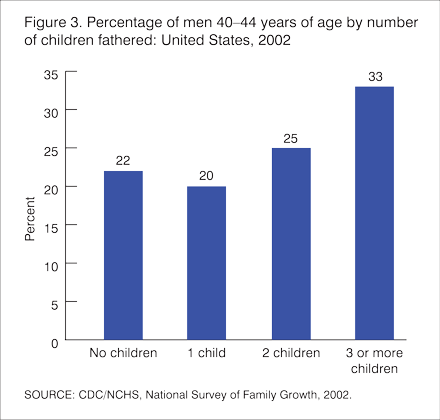Publications and Information Products
Information Sheet
May 2008
National Survey of Family Growth
PDF version 118 KB
Page Content
About NCHS
National Survey of Family Growth
Topics Addressed
Examples of NSFG Data
Challenges and Future Opportunities
About NCHS
The CDC's National Center for Health Statistics (NCHS) is the nation's principal health statistics agency. NCHS compiles statistical information to help guide public health and health policy decisions.
Collaborating with other public and private organizations, NCHS employs a variety of data collection mechanisms to obtain accurate information from multiple sources. Together, these data systems provide a broad perspective to help us understand the population's health, health outcomes, and the characteristics of births and deaths.
National Survey of Family Growth
The National Survey of Family Growth (NSFG) gathers information from a national sample of men and women 15-44 years of age in the household population of the United States. The survey includes topics related to: families, including cohabitation, marriage, and divorce; fertility, including pregnancy, infertility, and use of contraception; and health care, including use of health care for pregnancy and infertility. It also collects data on fathers' involvement in the lives of their children, and attitudes of men and women toward marriage, parenthood, and sexual behavior.
The NSFG has been conducted five times with national samples of women 15-44 years of age in 1973, 1976, 1982, 1988, and 1995. In 2002, the NSFG included a national sample of both men and women. Findings in this Information Sheet are from the 2002 NSFG.
NSFG results are released in standard NCHS reports, and NSFG public-use data are analyzed by researchers nationwide to produce articles for scientific journals as well as books and other reports.
Topics addressed:
-
Marriage, divorce, and
cohabitation
- Contraceptive use by men and women
- Sterilization
- Sexual activity among teens and adults
- Pregnancy and birth
- Fatherhood involvement and child support
- Sexual behaviors that increase risk of HIV
- Sexual orientation and attraction
- Use of medical services for infertility
- Use of medical services for family planning
Examples of NSFG Data
Figure 1 shows that in 2002, the most popular methods of contraception in the United States were the pill (31%), female sterilization (27%), the male condom (18%), and male sterilization (9%). Together, these four methods accounted for 85% of contraceptive users.
- At first intercourse, the condom is the leading method of contraception. Among women under 35 years of age, the pill is the leading method. After age 35, female sterilization is the leading method.
- Among college-educated contraceptive users, the pill is the leading method. Among those with a high school education or less, female sterilization is the leading method.

Figure 2 shows that about 9% of recent births to white women were to cohabiting women; among black women, 15% were to cohabiting women; and among Hispanic mothers, 22% of births occurred to women who were cohabiting. Among Hispanic mothers, nearly one-half of nonmarital births were to cohabiting women.
As shown in Figure 3, 22% of men 40-44 years of age in 2002 had not fathered any children. About 20% had fathered one, 25% two, and 33% had fathered three or more children.
Other findings from NSFG Cycle 6 (2002)
-
The NSFG collects data on breast-feeding. Two-thirds of babies born in 1997-2000 were breastfed. About one-third were breastfed for 6 months or more.
-
About three-fourths of fathers (73%) lived with all of their children; 14% did not live with any of their children, and 12% lived with some but not others.
-
About one-half of men and women 15-44 years of age have cohabited at some time, and about 9% are currently cohabiting.
-
In 2002, about 12% of persons 15-44 years of age (more than 14 million) were at elevated risk of HIV because of their sexual or drug use behavior in the last 12 months.
More examples of key findings from the NSFG are in the "Key Statistics from the NSFG (from A to Z)", at the following http://www.cdc.gov/nchs/about/major/nsfg/abclist.htm
Challenges and Future Opportunities
To improve the timeliness and usefulness of NSFG data, in June 2006 the NSFG began interviewing continuously. NCHS hopes to continue NSFG interviewing every year. The first data file and findings from the new design are expected to be released in late 2009, and every 2-3 years after that. The NSFG staff is also striving to improve the NSFG website to include more information, ranging from simple to technical, to serve a wide variety of data users. The survey's website is: http://www.cdc.gov/nchs/nsfg.htm.
For further information about NCHS and its programs, visit us at http://www.cdc.gov/nchs, or call the Office of Planning, Budget and Legislation at 301-458-4100.
Page Last Modified: November 20, 2008
Data Source: CDC/National Center for Health Statistics
National Survey of Family Growth Staff
Division of Vital Statistics
National Center for Health Statistics, 7th Floor
3311 Toledo Road
Hyattsville, Maryland 20782
(301) 458-4222
nsfg@cdc.gov
National Center for Health
Statistics
3311 Toledo Road
Hyattsville, MD 20782
Phone:
1-800-232-4636
nchsquery@cdc.gov
Centers for Disease Control and Prevention, 1600 Clifton Rd, Atlanta, GA 30333, U.S.A
Tel: (404) 639-3311 / Public Inquiries: (404) 639-3534 / (800) 311-3435

